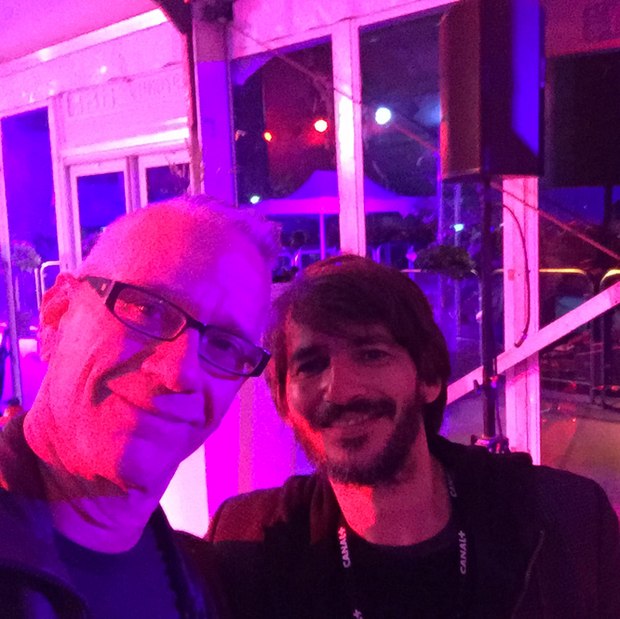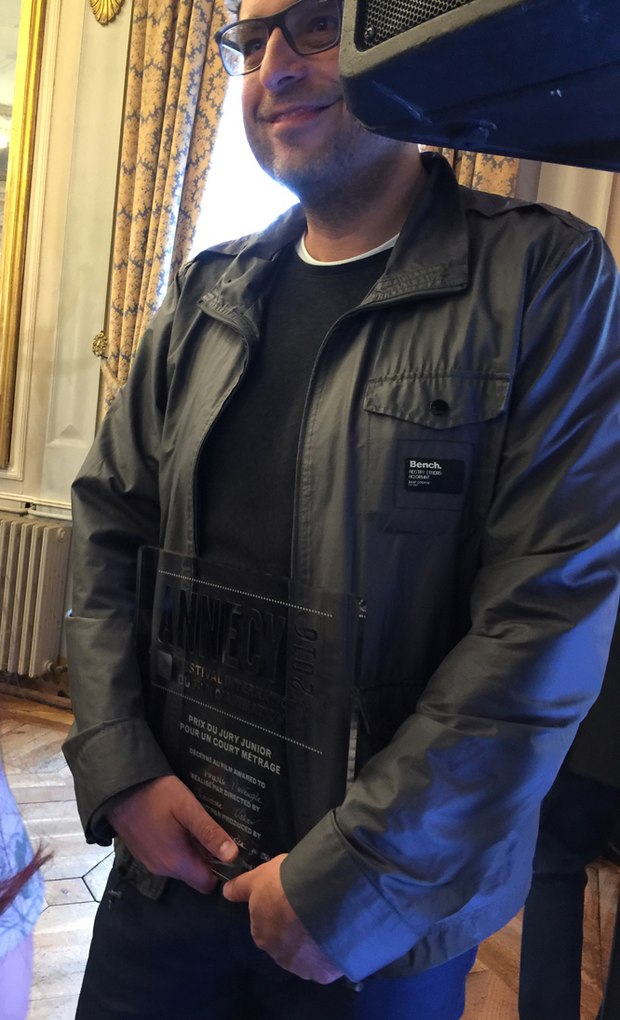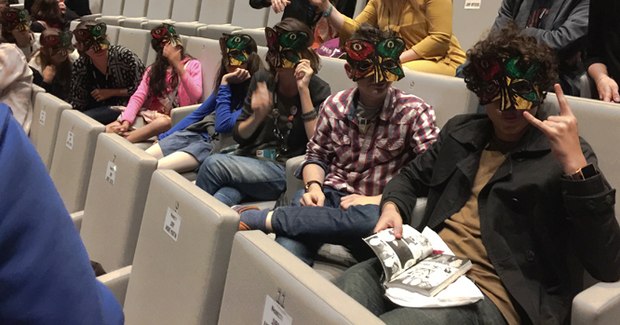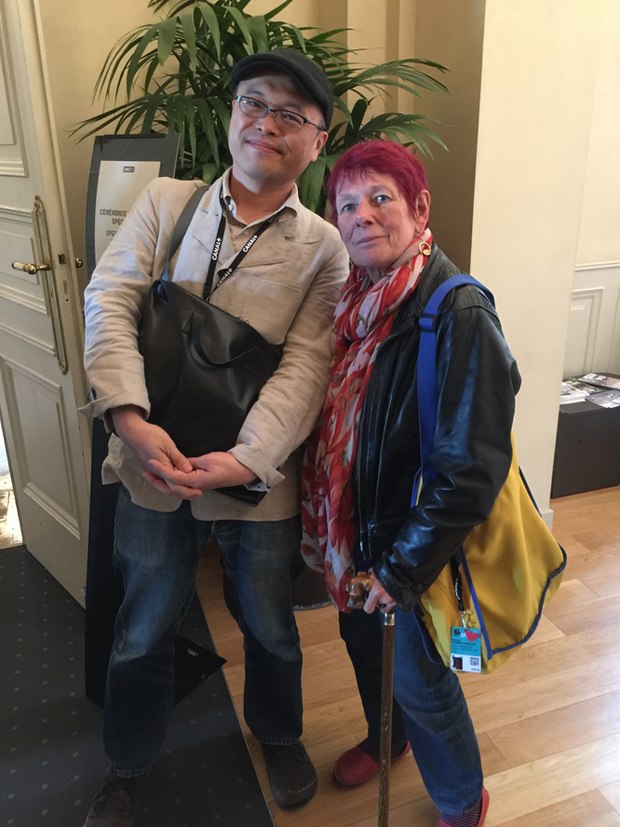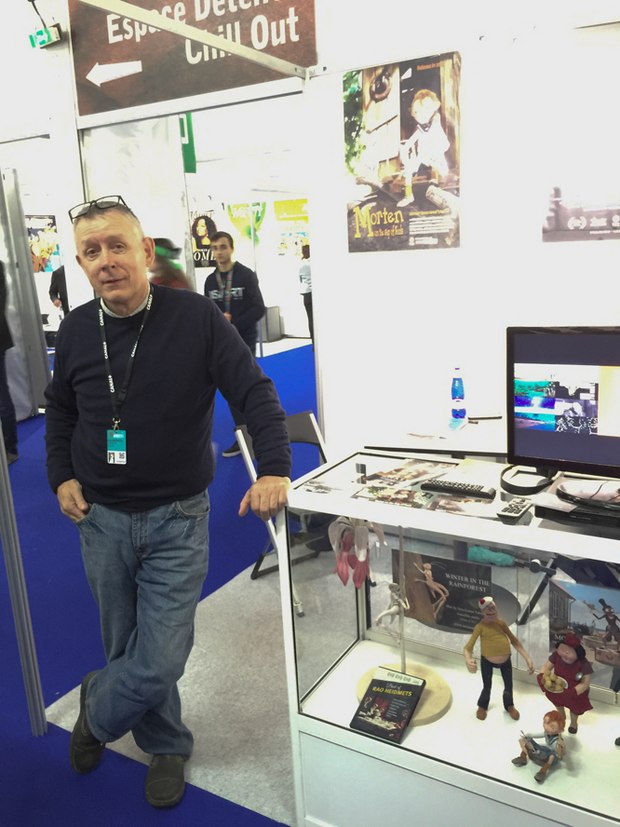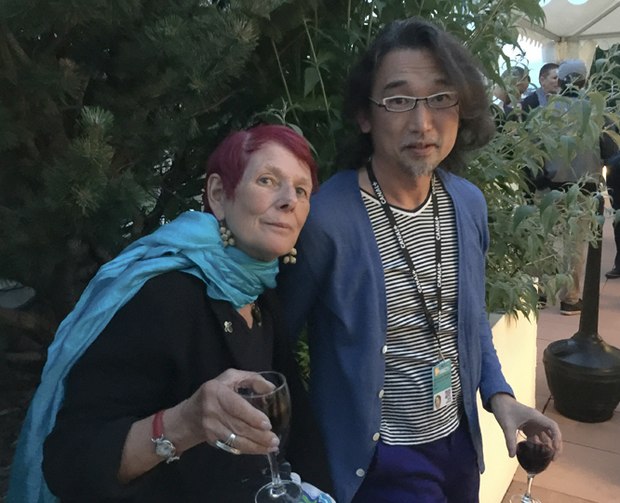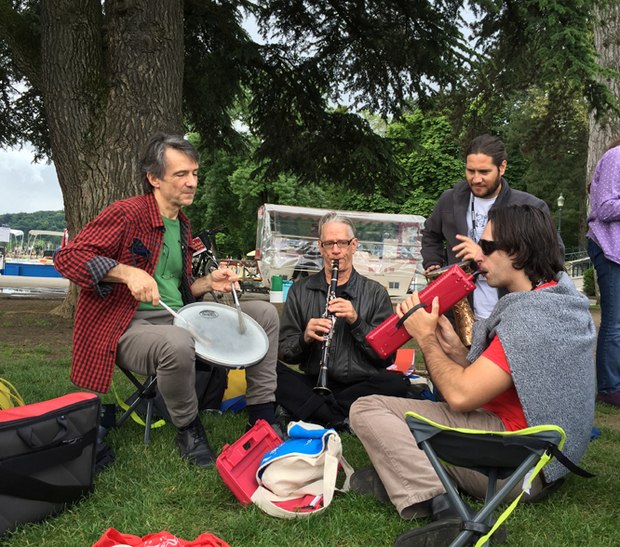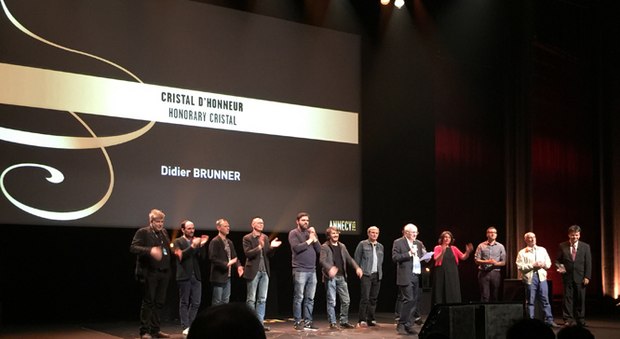9,000 Animators watching over 500 Films Screened in 6 Days: IT MUST BE ANNECY - 13 – 18 June, 2016, Annecy, France
My head was still full of beautiful memories of Animafest Zagreb as I flew straight from Zagreb to Annecy. After having so many problems with the Annecy event access last year, I was happy to discover that the 2016 edition was much better organized. The festival has finally worked out the bugs in their computer system, and festival registration and ticket reservations ran smoothly all week.
With 9,153 badge holders, up 10.3% from last year, there is no way that everyone could get tickets for all of the screenings that they wanted, but since you could book and cancel screenings with their phone app, it helped to make for fewer empty seats at those supposedly sold out screenings. And with 10 screening rooms scattered throughout the city and nightly special free screenings at the Musee-Chateau you could always get tickets for something. It just might not be exactly what you wanted to see or when and where you wanted to see it.
The opening night film was The Red Turtle, Michael Dudok de Wit’s long awaited first feature length film. It tells the story of a man marooned on a desert island who tries desperately to escape until the day he encounters the strange red turtle. It changes his life.
Michael said that he did not want to tell a story of how a man survives on a desert island because that has already been done many times. He explained “I spent time on one of the smaller Seychelles Islands, a name that evokes luxury vacations. But I made a simpler choice, living with locals for ten days . . . the idea was to avoid the holiday brochure aesthetic. My castaway couldn’t love the location; he wants to return home at all costs, as the island is not so welcoming. There are dangers, extreme solitude, rain, and insects . . .”
The film was a co-production between Studio Ghibli in Japan and Wild Bunch of France. In 2006 Toshio Suzuki of Studio Ghibli approached Dudok De Wit with the idea of working together on a feature film. Michael began the script in 2007. This is the renowned Studio Ghibli’s first co-production outside of Japan.
The film is visually stunning as you would expect from a collaboration between Dutch animator Michael Dudok De Wit (The Monk and the Fish, 1995 and the 2001 Oscar winning Father and Daughter) and Studio Ghibli. There is no dialogue, so the beautiful musical score by Laurent Perez Del Mar was extremely important to the storyline.
Unfortunately I felt that something was missing from the film. As visually lovely as the The Red Turtle is, it seemed to be too long, with scenes that were not necessary to move the story along. The film would have made a stunning 30 minute masterpiece but at 1 hour and 25 minutes I thought that the story began to lag a little over half way through. People that I talked to who saw the film either loved it or also thought that it was too long.
There were nine feature films in competition and eleven out of competition this year. The big buzz at the festival was about My Life as a Courgette, which won both the Best Feature Film Cristal and the Feature Film Audience Award. The delightful Swiss/French stop-motion film by Claude Barras is the story of a nine year old boy nicknamed Courgette (Zucchini in English). After his mother’s sudden death the boy is befriended by a kind police officer named Raymond who takes him to the orphanage which is full of children Courgette’s age. At first the boy struggles to find his place in his strange, and at times hostile, new world. With the help of Raymond and his new friends he eventually learns to trust people again and finally finds a new family of his own.
Barras has brought the book, Autobiographie d’ une Courgette by Gilles Paris, to life with appealing puppets and a main character that you care about and want to see find happiness. It has been selected as the Swiss entry for Best Foreign Language Film for the 89th Academy Awards and G-Kids has bought the North American distribution rights so hopefully it will be in theatres soon.
The National Film Board of Canada is known for their excellent short animation and this year at they had a lot to celebrate. Frank Dion received the Grand Prix Cristal for The Head Vanishes produced at the National Film Board. Jacqueline, the film’s main character, isn’t quite in her right mind anymore, but she is determined to take the train to the seashore, as she does every summer. Only this year, she is constantly being followed by a woman who claims to be her daughter. Her trip takes some unexpected turns.
Frank’s gentle, poetic 8 minute, 30 second film invites the view to share the journey of an elderly woman living with degenerative dementia, as her confused mind leaves her open to danger. The film is definitely deserving of the Cristal and I think this will not be its last major award.
Continuing an amazingly prolific stream of new animation following his 20th Century Trilogy, Blood Manifesto, and Sonambulo, Bulgarian born Theodore Ushev’s Blind Vaysha won both the Junior Jury Award for a Short Film and The Jury Award. The film, adapted from a short story by Bulgarian writer Georgi Gospodinov, is about Vayshu, a girl afflicted with the ability to see only the past out of her left eye and the future in her right eye. In this metaphoric tale of timeless wisdom and beauty Theodore reminds us of the importance of living in the present. The film is visually experimental utilizing drawings and linocuts to create a starkly disturbing 3D film.
Blind Vaysha was produced at the National Film Board by Marc Bertrand. For 3D screenings we were provided with unique 3D glasses in the shape of Vaysha’s face. Theodore told me that the Junior Jury award meant a great deal to him because he thinks of the film as a metaphorical fairy tale for kids from 9 to 99, and if the Junior Jury with an average age of 11 years old understood the film, he had accomplished what he set out to do. Kudo’s to a very intelligent and sensitive group of young people. At the closing night ceremony the Junior Jury donned their 3D glasses when their award was announced.
A new film by Japanese animator and illustrator Koji Yamamura is always a treat and his latest film Parade de Satie was a special surprise for me because I love Erik Satie’s music. The parade of three managers and four performers mixes quotes taken from French composer Satie’s essays on the music he composed for his 1916 ballet Parade with images of a surrealistic animated ballet. The music, performed by the Dutch ensemble Willem Breuker Kollektief, and Koji’s images brought this famous ballet by Leonid Massine back to life in this 14 minute film.
Each year Annecy features animation from a different country. This year the festival turned the spotlight on the rich history of French animation. With tongue planted firmly in cheek the catalogue announced the French Animation: The Mirror Effect by saying “Annecy is in France, and seen from that prospective, it’s a little like putting yourself in the spotlight. To avoid such an embarrassing situation, we have conceived a set of contrasting visions so that French animation on offer will be a reflection of how the rest of the world sees it.”
No such disclaimer is really needed because everyone knows that French animation stands out for its diversity, ambition, and such great names in cinema as Florence Miailhe, Robert Laguionie, and Michel Ocelot. France can also boast some of the most famous animation studios in the world and their schools offer the widest range of training programs available anywhere. Numerous French co-productions appear on festival screens throughout the world.
The 17 programs devoted to the exploration of all facets of French animation began with The Classics’ Classics curated by noted film historian Giannalberto Bendazzi. All seven films in the program, from Emile Cohl’s 1908 Fantasmagorie to Florence Miailhe’s 1999 delightful example of painting in motion Au premier dimanche d’ aout were a treat to see again on the big screen.
Ron Diamond, founder of the Acme Filmworks in Los Angeles, presented View From Hollywod which contained some of French animation’s recent international successes such as Jeremy Clapin’s Skhizein. Shelly Page, who isHead of International Outreach at DreamWorks selected 15 films from 9 different animation schools for the Best From Schools screening.
The most intriguing French program, Un Unexpected Account of French Animation posed the question “What if Norman McLaren had been French?” Marco De Blois, programmer and curator at the Cinematheque Quebecoise, Canada posed this question and then combed the vast archives of French animation to find the answer to his question. For the 9 films in the program Marco unearthed engraving on film (Surprise Boogie, 1957 by Albert Pierru), visual music (Symphonie printaniere by Henry Valens in1934), special effects ( Emile Cohl’s 1910 Le Mobilier fidele), chronophotography (Allegro ma troppo, 1962 by Paul de Roubaix) and CGI, represented by Peter Foldes 2009 Youki. Marco even included Publicite Michelin: Empreintes, a 1960 commercial by Jean Mineur, as a nod to McLaren’s several public service messages.
To end the program Italian composer and sound designer Andrea Martignoni gave a live musical performance during the 35 minute screening of Symphonie printaniere, Henry Valensi’s 1934 silent film. The program was full of delightful surprises and made me feel that the Scottish/Canadian McLaren must have had bit of French in his soul.
Each year the first program that I see at Annecy is The Big Sleep. This program pays tribute to those people involved in the animation industry who have passed away since the last Annecy. It is bittersweet, and it is important to pay homage to old friends, their great contributions to animation, and the beloved films they have left us. The first of the five animators in the program was Jane Aaron (1948-2015). Traveling Light and Set in Motion are two of the best known films by the New York animator and illustrator. In Traveling Light, Jane used pixilation to depict rays of light and shadow as they travel across the outside and inside of a house.
For Set in Motion, Jane used stop-motion to animate cut out bits of material and paper that move around furniture, walls and other household fixtures. Jane went on to create over 150 segments for the Children’s Television Workshop’s famous series Sesame Street over a 17 year period. Even though her name may not be known to the millions of children who grew up watching the show, they learned their alphabet and counting from Jane’s colorfully animated letters and numbers.
If Robert Balser had created nothing more than the opening sequence of Around the World in 80 Days and worked on George Dunning’s Yellow Submarine in his 50 year career he would be remembered for his contribution to popular culture. In the field of television he contributed his talent to The Charley Brown and Snoopy Show. Balzer was born in the United States and lived in Barcelona for many years, where he created his short The Hat in 1964 at Estudios Moro. His story of a social outcast who is bareheaded in a society where everyone else wears a hat has become a classic example of social commentary.
Giuseppe Lagana had a long career that reflects the history of Italian animation. Beginning in the 1960’s Giuseppe became one of the main collaborators at Bruno Bozzetto’s studio. He worked on several TV series and created a children’s feature film, Felix-All Around the World. He is best remembers for the 1982 4’30” film Pixocchio where he collaborated with Guido Vanzetti to create Italy’s first computer animation.
Canadian Colin Low, who was hired by the National Film Board of Canada at the end of WWII, became known for his innovative techniques. Although he was best known for his documentaries he made vast contributions to the world of animation including introducing cel animation to the NFB. His animated short The Romance of Transportation in Canada was nominated for an Oscar in 1952 and won a Palm d’Or at Cannes. Low became one of the pioneers of IMAX, participating in its technological development from the ‘60’s through the ‘90’s.
Last but not least, we bid a fond farewell to Spanard Pascual Perez Porcar. He began his career working for Bolex Brothers, and other production studios. After playing around with plasticine and the family super-8 camera, he started his career working on the 2-D animation series Cutless before joining Conflictivos Productions managed by Sam Orti. He worked with Sam on such shorts as The Werepig and Vicenta as well as Sam’s extremely clever puppet feature Possessed, a tribute to classic horror films. He also worked on many Aardman productions. In 2011 Pascual made his own personal film Story of Him. The film about a little guy who just can’t stop knocking back beers and coffees was screened as part of The Big Sleep.
The festival’s Artistic Director Marcel Jean has had a positive influence on Annecy’s programming which I thought was quite positive this year. No matter what area of animation you are interested in –from shorts and features to television and commissioned films – there was pleanty to see. Marcel is also an excellent interviewer, so the opportunity to hear the filmmakers speak every morning at Shorts and Breakfast was most informative. Marcel has a knack for asking intelligent questions and then letting the filmmakers take center stage and give in-depth answers to questions.
MIFA, the business and market arm of the festival, celebrated its 30th anniversary in 2015. It has grown so large that it has now taken over the Imperial Palace Hotel and expanded to a massive tent adjacent to the hotel. MIFA has become a major meeting place for animation buyers and distributors with 530 exhibitors from 68 countries. In addition to the exhibition booths MIFA hosted numerous conferences, keynote speeches, masterclasses, and making of sessions.
A meeting to announce the founding of the European Animation Awards was held at the Imperial Palace. The aim of the Awards is to honor the European Animation Industry in much the same way that the Annie’s honor American animation and the people working in all of the various forms of the industry. The idea was conceived by producer Didier Brunner when he attended the 42nd Annie Awards Ceremony and realized that there wasn’t a similar event to honor the European Animation Industry.
The first ceremony will be held in 2017 and all EAA members will be eligible to vote for the 20 different Emile Awards. The award is named after two figures of cinema: Emile Reynaud (1844-1918) and Emile Cohl (1857-1938. Reynaud was the French inventor and creator of the first cartoon, who presented his Pantomimes Lumineuses on 28 October 1892, a date which is now known as World Animation Day. Cohl was a French illustrator and animator and he is considered to be the first director of animation. He created more than 300 films using a variety of techniques. A Life Time Achievement Award, The Lottie, will also be awarded to a person who has made a valuable and lasting contribution to European animation.
The 15 member board of the European Animations Award consists of an impressive group of animators, festival directors, and animation historians. Peter Lord has the honor of being selected as the first European Animations Award President. You can learn more about the new organization and how to become a member at: animationawards.eu
As Aardman Studios gears up to celebrate its 40th Anniversary the second MIFA/Variety Animation Personality of the Year Award was bestowed on both Peter Lord and David Sproxton, co-founders of the renowned studio, at a ceremony at MIFA. The award honors those who have contributed to the evolution of the animation industry through their work and achievements. I can’t think of two more worthy winners. Aardman is revving up for production on a new feature film Early Man directed by Nick Park for release in 2018.
Jeffrey Katzenberg received Annecy’s first Golden Ticket, a lifetime pass to the festival, for “his legendary animation track record.” It was presented at the end of the Keynote Master Class of director Guillermo del Toro which was attended by over 1,000 people. Del Toro and Katzenberg spent much of the second half of the talk discussing DreamWorks Animation/Netflix’s upcoming series Trollhunters which Guillermo produced. The Golden Ticket Award had been kept a complete secret and it was evident that Katzenberg didn’t suspect a thing when Marcel Jean came on stage to ask him about highlights in his career. Jeffrey was completely surprised when he was given the award and was almost speechless for a minute.
How important MIFA has become was underscored by a Thursday visit from French President Francoise Hollande and the Minister of Culture and Communications Audrey Azoulay. The already high security at both the festival sites and MIFA became even more intense for the visit. The festival busses stopped running to and from MIFA for several hours, the streets were blocked off, and high security French police dresses in robocop riot gear were standing around in the rain everywhere.
The parties at Annecy are very important if you are there to do business. With over 9,000 attendees it is possible to go all week without running into someone unless you are attending the parties. Even if you do run into someone you want to talk to at the screenings, you are both usually in a hurry to get somewhere, so parties are the place to have relaxed visits. The torrents of rain that turned the city into masses of puddles this year didn’t dampen the party mood one bit.
Although the threat of rain hung over the German Party Tuesday evening, it held off and after a short bus ride around the lake the guests were treated to a sumptuous feast. Tables were scattered around the lawn of the rustic restaurant down to the lakes edge, where Nik and Rolf Bächler on clarinet and percussion provided music. The annual event is sponsored jointly by the MFG Filmforderung Baden-Wurttemberg, The Stuttgart International Animation Festival, FMX, the DokLeipzig Festival, and the German Film and Short Film Association. I always look forward to this party because it is a chance to get away from the craziness of the festival and relax with friends over delicious food and copious amounts of beer and wine.
Wednesday Nik and I visited with our Russian friends from KROK at their reception. From there we rushed to the Danish picnic before heading to the Swiss reception where we got a sneak preview of new Swiss animation. At the Hiroshima Party Sayoko Kinoshita, Director of the Hiroshima Festival, entertained us with a charming traditional dance.
The evening ended at the MIFA opening reception at the La Plage Restaurant. Many people who have booths at MIFA never get to the Bonlieu, the main festival screening venue, so the MIFA party is often my only opportunity to see them and catch up on their new projects.
I got to sit down and talk with Shuzo John Shiota from Japan who was a member of the Short Film Jury. He told me that in 1997 he took part in the launch of Dream Pictures Studio. Two years later he moved to Polygon Pictures where in 2003 he became President and CEO. Polygon creates commercials and 3D CG anime TV series as well as the animation for the Disney XD series Tron: Uprising and several episodes of Star Wars: The Clone Wars which was broadcast on Cartoon Network. Tron received Annie Awards in 2013 for Character Design and Production Design. Shuzo told me that Tokyo based Polygon Pictures latest project is Lost in Oz, a 3D CG animation based on L. Frank Baum’s Oz Books. It will stream through Amazon Prime Services worldwide. The release date has not been announced yet.
Thursday the heavens opened up and rain poured down all day. Our morning began with breakfast with the Taiwanese delegation where I met director Li-Wei Chiu. Later that day at the Taiwanese reception at MIFA Li-Wei showed me the trailer for his feature film Barkley. Barkley the cat lives in an animal city. One day Fido, a young human boy, stumbles upon the animal city where he meets Barkley. Fido and Barkley set out to find the boy’s way back home. Barkley is a charming orange cat who captured my attention right away because I am very partial to ginger cats. The children’s film is due out in time for Christmas 2016.
By the time the Cartoon Network Picnic began at noon rain was coming down in buckets. The party is traditionally held on the beach at La Plage but due to the rain it was moved inside. Because a lunch for the France’s President was also being held in the restaurant, our party was relocated to the restaurant basement. The move caused long delays but didn’t deter a large crowd from standing in the rain waiting to get into the packed basement.
Thursday is the traditional “day of many parties” and there were too many at MIFA and the festival to mention them all. Luckily all of them except the Cartoon Network picnic were planned for indoors. It was such a frantic rush that Nik and I finally split up with him going to the Dutch party where he played music with Rolf Bächler and melodica player Wez Allard. I went to the Flemish Party hosted by Anima Brussels. The long day ended with the Nickelodeon Bowling Party.
Friday’s events began with the annual Dreamworks picnic hosted by Shelly Page, Head of International Outreach at Dreamworks Animation. Shelly thinks of everything. Last year she provided tables scattered around the lawn full of delicious food and this year they really came in handy because the ground was very wet. Shelly’s picnic is always such a special event because everyone from Oscar winning directors to up and coming young animators are there and everyone introduces themselves to whoever they are standing next to and chats. I am sure that animation projects have been hatched from the meetings at this picnic and it was definitely the place to be on Friday.
Before heading up to La Plage that evening for the Pixar Bar-b-que Nik and I attended the Special Prize Ceremony at the beautiful Hotel d’ Ville (City Hall). Jean-Luc Rigant, Mayor of Annecy, was present to see the Junior Jury present their Short Film Award to Theodore Ushev. Other awards given out included the Andre-Martin Award for a French Short Film to David Coquard-Dassault for Peripheria and the FIPRESCI award given by the International Federation of Film Critics which went to Michelle and Uri Kranot for How Long, Not Long. Michelle and Uri are known for their strong political films and How Long, Not Long is no exception. The film is a visual journey that challenges the viewer to think about a universal belonging that doesn’t confine anyone to a city, region, or national boundary in an age when xenophobia, nationalism, and intolerance are ubiquitous. The ceremony was followed by a reception to honor the winners.
With all of the rain I was worried that we would not be able to host our annual picnic, paddle boat race, and rounders game on Saturday afternoon. Even though the lawn in front of the Bonlieu looked like a lake the sun came out for us and we found the one big dry area on the entire lawn. Nik and I started the picnic years ago because most of the parties and receptions will not let anyone in without an invitation and we wanted to have a party that anyone can come to. Over the years it has become a very popular tradition where everyone from Oscar winning producers and directors to students sit on the grass talking, listening to the music, eating and drinking next to the lake. Everyone brings food or drink to share and it is a good opportunity for people who may be hopping that they will get an award that evening to forget all about it and chill out for a while. This year a special thanks goes to Jose Inesta, Director of the Pixelatl Animation Festival in Cuernavaca, Mexico and his crew for the case of Mexican beer they brought.
Just as our picnic was getting started a gentleman came by and was impressed with the lovely array of food that was spread out for the picnic. He asked who we were and why were we having a picnic there by the lake. After we explained that we were an international group who were in Annecy for the festival and that we got together annually on Saturday afternoon at this same spot he told us that he was a reporter for the Annecy newspaper and interviewed us. He was fascinated that there were so many nationalities represented and that we had gathered on Saturday afternoon for so many years. The next day in the Annecy local paper le dauphiné libéré there was a picture of us with an accompanying article.
Sadly the Squiggly Rounders game which Joanna Quinn founded years ago at the picnic had to be canceled because the playing field was so full of puddles that it would have looked more like mud wrestling than rounders but it will be back next year.
Conditions were perfect for the paddle boat race. The sun was shining but the waves on the lake were choppy which made for some very novel peddling tactics. After some spectacular and fierce peddling out to the island, around it, and back to the dock, the judges declared the winners. Unfortunately I don’t know the names of the winning duo but they were very pleased with their bottle of champagne and chocolate that their hard peddling earned them.
At the closing night ceremony along with the announcement of the juries decisions, a special Honorary Cristal was awarded to French producer Didier Brunner for his outstanding contributions to French animation. Brunner began working in the film industry as an assistant director and later as a director of educational documentary films. After moving to animation he has become one of the driving forces of European feature animation films. In 1998 he was responsible for producing Michel Ocelot’s beautiful film Kirkou and the Sorceress. The film received rave reviews, sold over 1,400,000 tickets at French box offices and was distributed in over 40 countries. His other producing credits include the Princes and Princesses (2000) also by Ocelot, Sylvian Chomets’ The Triplets of Belleville (2003), Tomm Moore’s 2008 The Secret of Kells and Benjamin Renner, Stephane Aubier and Vincent Patar’s beautiful Ernest et Celestine (2012).
In 2014 Brunner left Les Armateurs, the production company that he founded in 1994. Word was that Didier was going to retire but he is now head of a new company, Folivari, with new projects in the works. After receiving his award he was joined on stage by many of the animators he has worked with over the years. The audience gave Didier Brunner a standing ovation. Following the awards ceremony the closing night party was held at the La Plage.
For the first time in years I thoroughly enjoyed Annecy and am looking forward to the 2017 edition. A big thank you goes out to Laurence Ythier, Head of Media Relations and her staff in the press office for making my job so enjoyable and easy. A complete list of all of the winning films follows.

